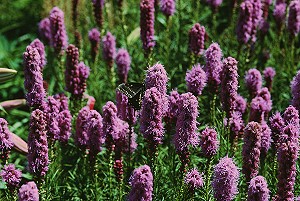Taking into consideration the factors listed below will assure your wildflower planting efforts will produce the best results.
 When to Plant
When to Plant
The best time to plant annuals, perennials, or mixtures of annuals and perennials is in the spring, early summer or very late fall. Fall plantings should be late enough so that seeds do not germinate until spring. Perennials can also be sown in early fall provided that there is enough growing time before the plants go dormant for the winter.
Planting Rates
A good average rate to achieve, would be approximately 120-140 seeds per square foot (8 to 22 pounds per acre), and is recommended for maximum color. Avoid using more than the recommended rates since poor perennial establishment may result.
Site Preparation
Proper site preparation is important for prompt germination of seed and healthy growth of seedlings. Best results will be obtained by planting on cleared ground. Remove existing vegetation to avoid competition from other plants. This may be done by pulling, tilling under, spraying with a general herbicide, or by a combination of these methods, and depending upon the size of the area, type, density of vegetation, and other factors. Loosen soil by scraping, tilling or scarifying. The key is to remove all vegetation before planting.
Weed Control
Weed control is the biggest problem facing wildflower establishment and has no easy solution. Weed seeds are present in many situations and lie dormant, but viable, for long periods of time. A weedy area converted to wildflowers will have a large reservoir of weed seeds in the soil, ready to germinate when conditions are favorable. In most cases, it is advisable to consider weed control in two phases-as part of site preparation prior to planting, and as an important component of the post-germination maintenance program.
Before planting, remove existing weeds by pulling, tilling under, applying a general herbicide such as Roundup or KLEENUP, or by a combination of these methods. For additional weed control after site preparation, a soil fumigant may be used, or the area may be irrigated to encourage weed growth and then sprayed with a general herbicide.
In very weedy areas, the following method is suggested: (1) Till soil or spray vegetation with Roundup or KLEENUP. When using an herbicide, allow vegetation to die, and then rake out the dead debris. If perennial weeds are present using an herbicide is more effective than tilling. (2) Irrigate to encourage germination of weed seeds near the surface; most seeds will germinate within two weeks if consistent moisture is available do not till the soil again because this will bring even more weed seeds up to the surface. (3) Spray any new growth with Roundup or KLEENUP. (4) After raking out dead vegetation, allow soil to recover for 3-4 weeks before planting with wildflowers.
Once the wildflowers have germinated, further weed control is usually necessary. If practical, pull all weeds as soon as they can be identified.
Other successful techniques are spot-spraying with a general herbicide or selectively cutting weeds with a string trimmer. Be sure to remove weeds before they reseed.
Many unwanted annual and some perennial grasses can be controlled with the herbicides Ornamec® and Fusiade. These post-emergents do not affect broad-leaved plants so that they can be applied over existing wildflowers; they are most effective when sprayed on new growth and young plants. Take care to avoid treating areas with desirable native grasses or fescues.
Seed Application
Method of application depends on the size of the area and the terrain. On small areas, broadcast seeds evenly either by hand or by use of a drop or cyclone spreader. It is helpful to mix a carrier such as clean, dry sand with the seed; sand adds volume and aids in even distribution. We recommend using a ratio of 1 or 2 parts sand to 1 part seed. Rake in lightly, covering seed to a maximum depth of 2-3 times their thickness. Or drag the area lightly with a piece of chain link fence to mix the seed into the surface of the soil. For seeding large areas, i.e., over one acre, specially designed drills are most effective. Drill to a maximum of ¼ inch and firm soil with a cultipacker; this maximizes seed/soil contact. Hydro seeders are also effective, especially for steep slopes, rocky terrain, and other areas where conditions make it impractical for driving equipment. If at all possible rolling the seeded area would be wise to achieve a soil to seed contact.
Moisture
All seeds, including wildflowers, need ample moisture to germinate and to develop into healthy seedlings. Water the planted areas thoroughly and maintaining consistent moisture for 4-6 weeks and then gradually reducing waterings will obtain best results. In non-irrigated situations, plant in the spring or before periods of anticipated rainfall. After seedlings are established, watering may be reduced depending on the climate and rainfall. In arid climates or during drought conditions, up to ½ inch of supplemental water per week may be required to maintain an optimal display. If weeds are present, remember that they benefit from moisture as much as the wildflowers and may dominate over-watered areas.
Fertilization
Do not fertilize wildflowers unless the soil is extremely depleted of nutrients. Fertilizers encourage weed growth and lush foliage rather than flowers. If the soil needs improvement, we suggest adding organic matter such as weed-free grass clippings or straw, well-rotted compost, peat moss or leaf mold. In addition to adding nutrients, organic materials enhance soil texture and encourage beneficial microorganisms.
next: Care and Maintenance...
